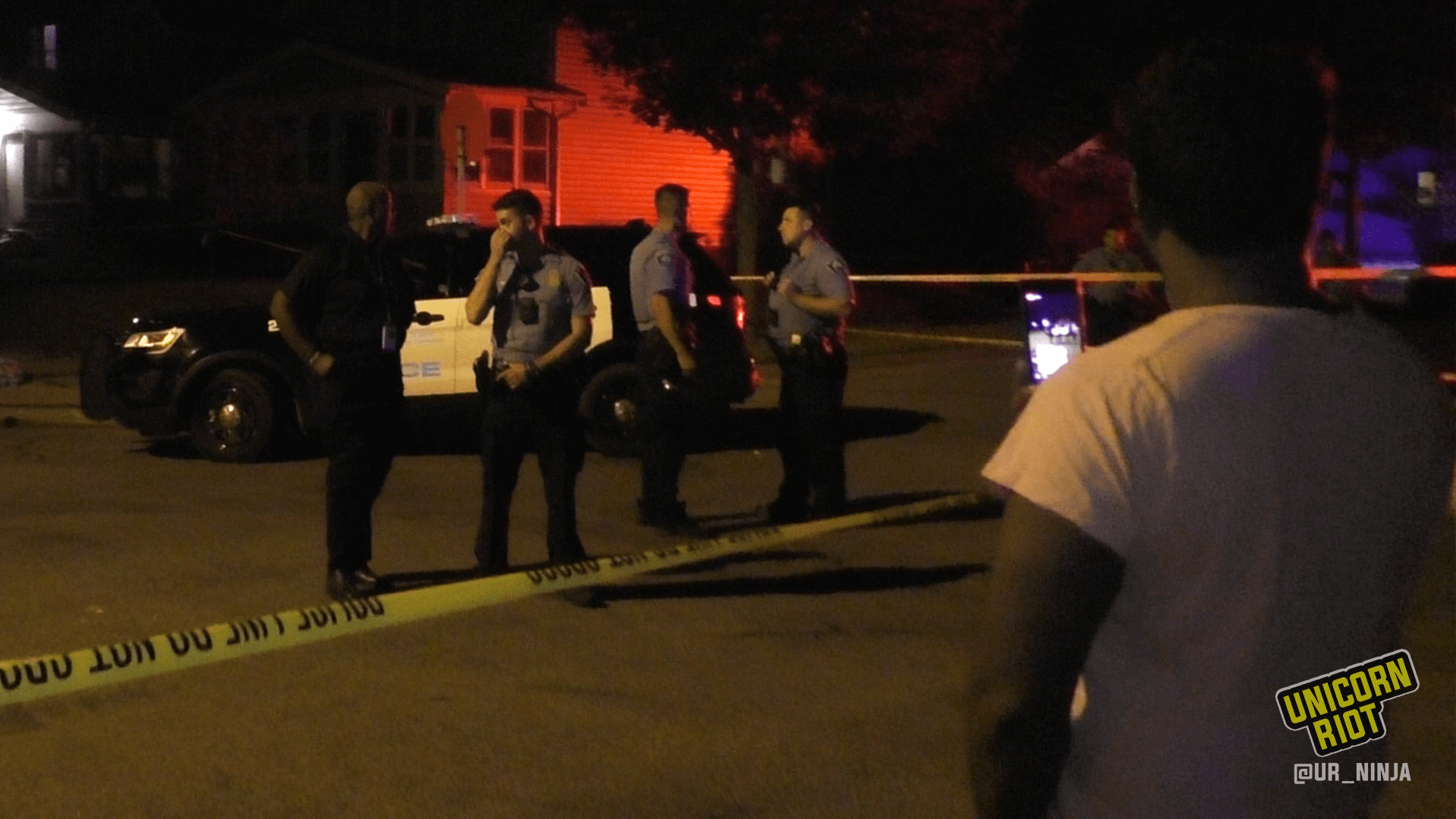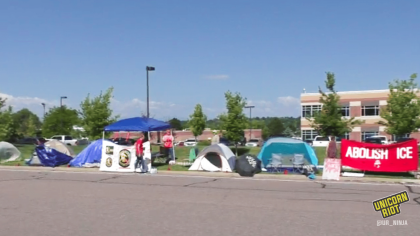Record Numbers of Complaints Against Minneapolis Police Amidst Ketamine and Killings
Minneapolis, MN – The public has filed staggering numbers of complaints against the Minneapolis Police Department (MPD) in 2018, and high-profile incidents of police misconduct, brutality, and killings have embroiled the department. A year after an MPD officer killed an unarmed Australian, Justine Damond, and a month after killing Thurman Blevins with shots to the back, a number of videos and reports indicate misconduct by MPD and other Minneapolis-area authorities.
NEW REPORT: Record Numbers of Complaints Filed Against @MinneapolisPD in First Half of 2018 Amidst #Ketamine and Killings https://t.co/JCWtMXEQkD #ThurmanBlevins #JustineDamond #Minneapolis #Police pic.twitter.com/GlGQgI5KDG
— Unicorn Riot (@UR_Ninja) July 29, 2018
The last 29 seconds of Blevins’ life on audio was released by local corporate media on Friday, June 27. In the audio it seems as if Blevins’ last words are “please don’t shoot me,” “leave me alone,” and “I’m unarmed” before he was shot to death in a North Minneapolis alley by officers Ryan Kelly and Justin Schmidt.
Along with a 115-page report (PDF) released by the city showing that officers urge emergency medical services (EMS) personnel to inject detained people with ketamine, public data shows consistently racist policing continues. While use of force incidents are down, complaints are soaring.
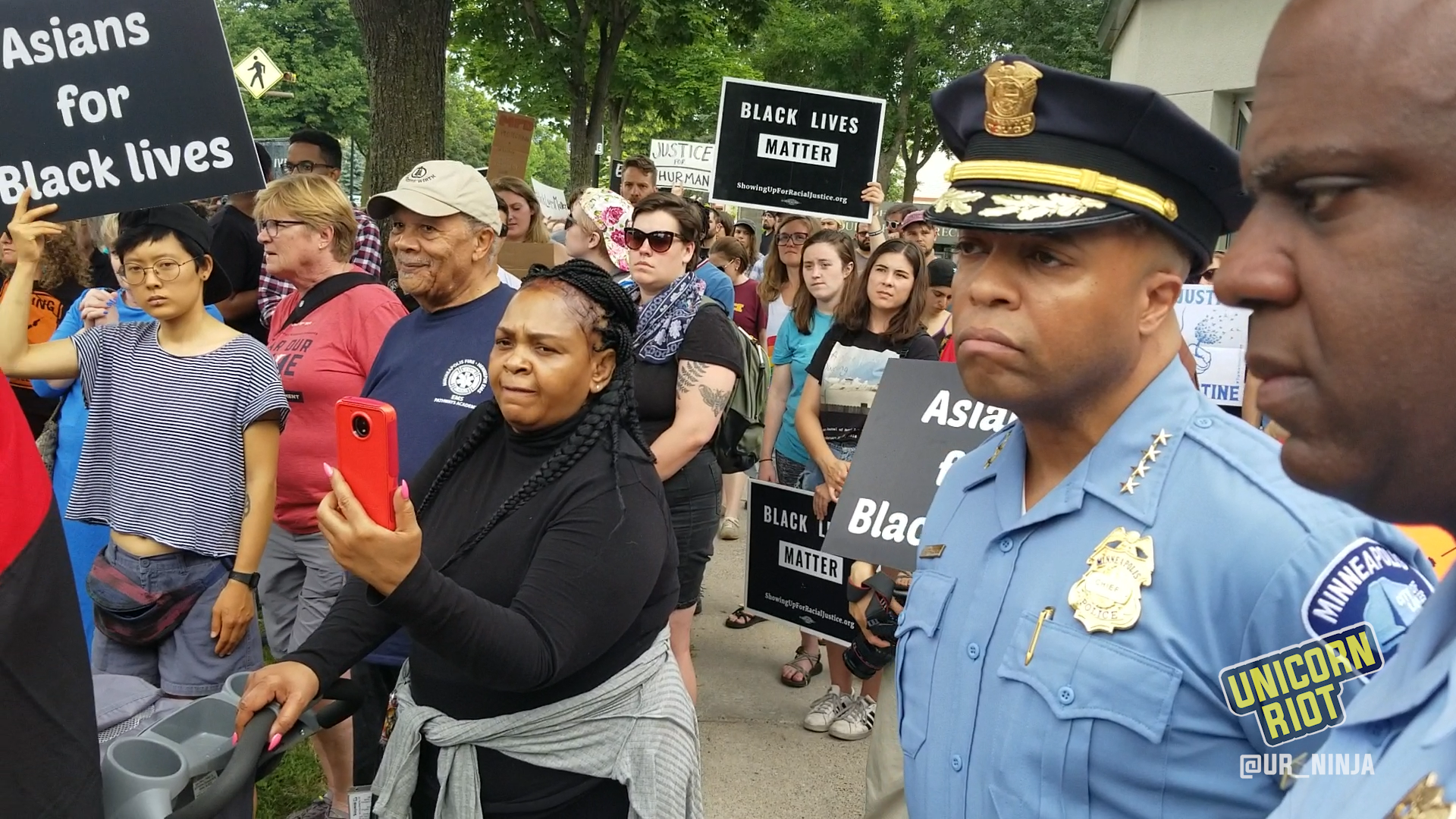
Many believed that Minneapolis Police Chief Medaria Arrandondo could expediently change the culture of the police force, increasing trust and serving its population with more care. After all, Arradondo, the first African-American police chief at MPD, who is respected by many in the city, was a victor in a racial discrimination lawsuit (PDF), with a slew of other 4th Precinct officers, against the same force that he now leads.
With record numbers of public complaints, many recent high-profile incidents, transparency actions by authorities, and community conversations around the Minneapolis Police, we decided to provide a broad-strokes look at some of the cases, stories, and statistics.
COMPLAINTS AGAINST POLICE STAGGERINGLY HIGH FOR FIRST HALF OF 2018
According to up-to-date statistics from the Office of Police Conduct Review (OPCR), an extraordinary 251 complaints have been filed against Minneapolis Police officers in the first two quarters of the 2018 year.
The 251 complaints against MPD in the first half of the year almost equals the yearly average of the last five years, 253. A staggering 164 complaints were filled in the second quarter alone.
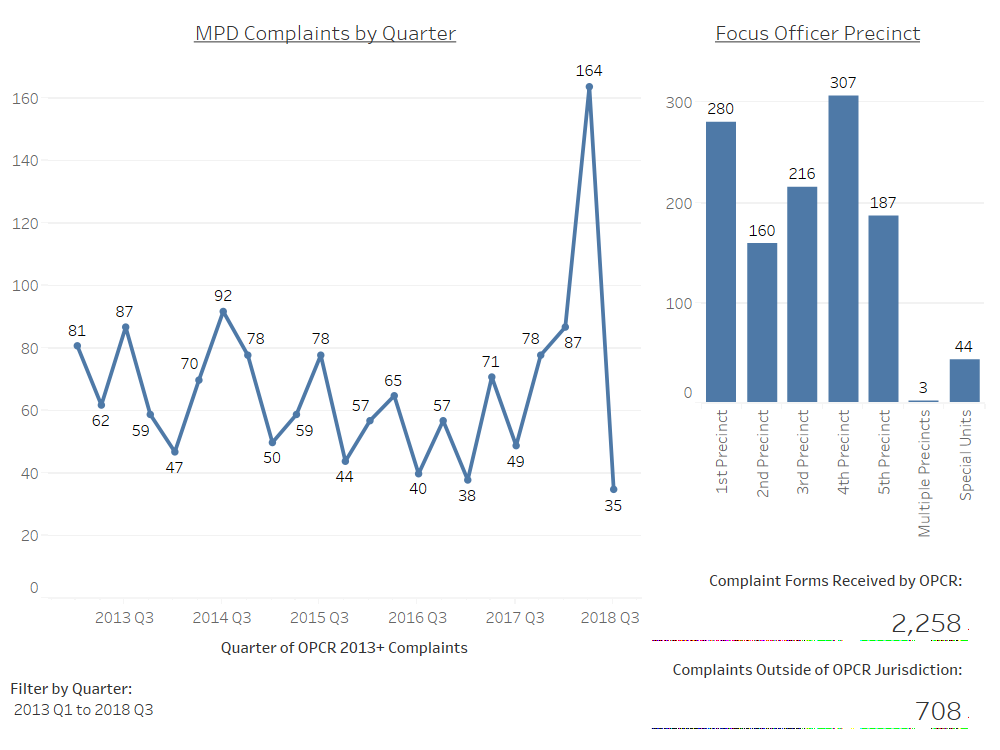
The three highest months of the last five years of complaints taken against the MPD have occurred in the most recent four months of 2018. In May, 98 complaints were filed; 51 filed in June; 47 were filed in March of 2018.
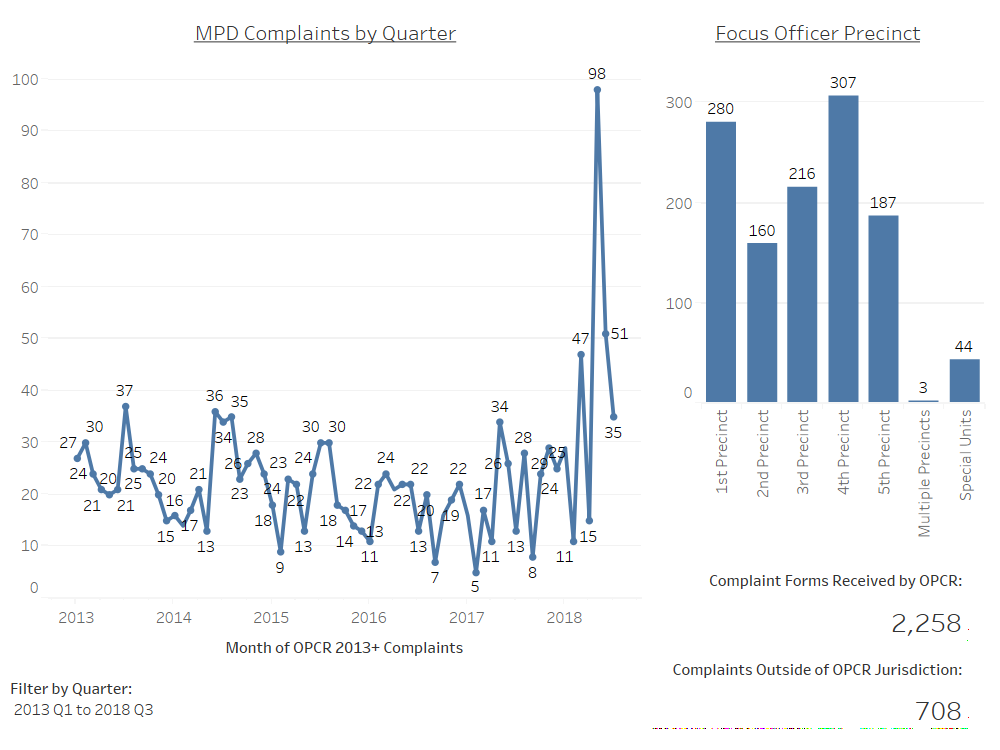
The OPCR, was recently granted extra authority to “facilitate research and study projects” by a changed ordinance in 2017. Though they have recorded the record number of complaints from the public, they are said to have a less than one percent sustain and discipline rate for complaints (national average for police accountability agencies runs 7-8%).
MPD OFFICERS, CHIEF, AND EX-CHIEF SUED FOR $50 MILLION BY JUSTINE RUSZCZYK FAMILY
A federal civil rights lawsuit was filed last week by the family of Justine Ruszczyk aka Justine Damond seeking $50 million in damages and accusing the MPD of violating Justine’s constitutional rights while implicating the Minneapolis Police Federation and the officers involved in covering it up.
Australian native Justine Ruszczyk ‘Damond’ was killed by MPD officer Mohamed Noor while him and his partner Matthew Harrity were responding to a 911 call of a potential woman in distress in the alley of her southwest Minneapolis neighborhood made by Justine herself.

The lawsuit, filed a year and a week after the murder of 40-year-old Justine, names the city of Minneapolis, MPD officers Noor and Harrity, the former police chief Janeé Harteau, as well as former assistant chief, now acting chief Medaria Arradondo, as defendants and claims $50 million in damages.
The lawsuit details (PDF) “conscious failures to collect evidence and obey MPD policies“, calls for sweeping changes, including ways it psychologically tests for officers, and says the “blue wall of silence remains alive and well within the MPD“.
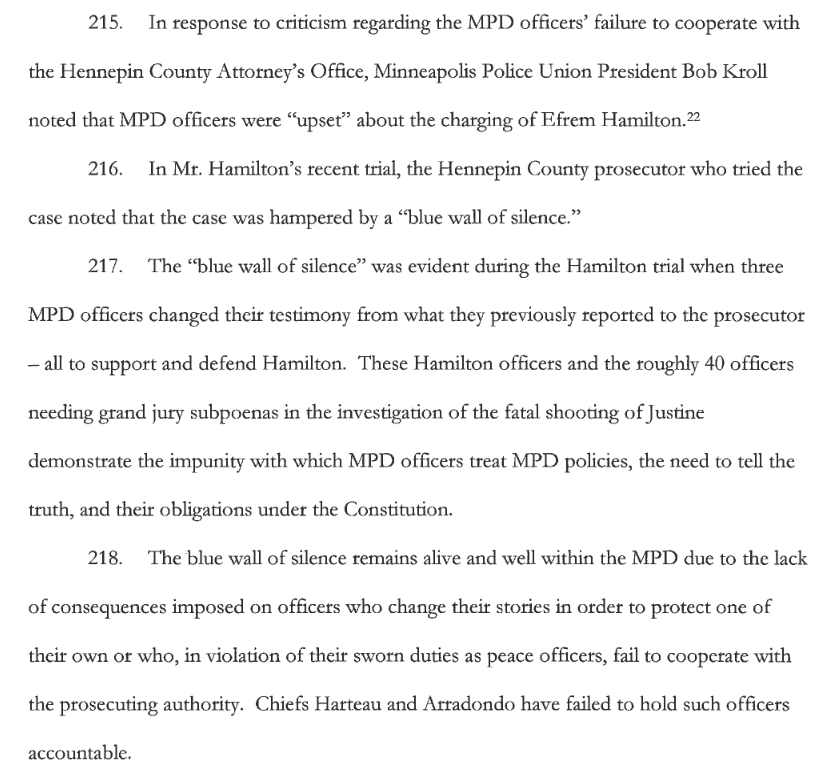
The “blue wall of silence” in the lawsuit referenced Minneapolis Police Officer Efrem Hamilton’s trial in early 2018 for shooting into a car full of youth in downtown Minneapolis (body cam video).
Hamilton was found not guilty on multiple felony charges and the lawsuit quotes that during the trial, “three MPD officers changed their testimony from what they had previously reported to the prosecutor.”
Furthermore, the lawsuit states that ~40 officers, who wouldn’t willingly speak to the Hennepin County Attorney’s Office, had to be subpoenaed to speak about the Rusczcyk shooting.
“These Hamilton officers and the roughly 40 officers needing grand jury subpoenas in the investigation of the fatal shooting of Justine demonstrate the impunity with which MPD officers treat MPD policies, the need to tell the truth, and their obligations under the Constitution.” – Rusczcyk Civil Rights Complaint
See the lawsuit below:
Ruszczyk-Civil-rights-complaintIt was Justine’s death that led to former MPD Police Chief Harteau’s resignation and Arradondo’s appointment to head the MPD. Noor, fired by the MPD in March after having third-degree murder and second-degree manslaughter charges filed against him (PDF) in Rusczcyk’s death, has a September court date scheduled.
“PLEASE DON’T SHOOT ME”, “LEAVE ME ALONE” – BLEVINS’ LAST WORDS
On Friday, June 27, KSTP released audio from a neighbor’s security camera close to where Thurman Blevins was fatally shot by MPD. In the last half a minute of Blevins life, he can be heard in the audio yelling back at police who are threatening to shoot him if he doesn’t put his hands up.
His last words are “please don’t shoot me“, “leave me alone” and what sounds something like, “I’m unarmed” or “I’m not armed,” before he was shot to death in the alley by a dozen or so gunshots, including to his head.
Unicorn Riot spoke with witnesses to Blevins’ death hours after the incident. None of them indicated a gun was in his hand. A neighbor claims he saw a gun laying next to Blevins after he was shot near his garage.
BODY CAMERA FOOTAGE FROM BLEVINS KILLING TO BE RELEASED IN NEXT DAYS
A lot of energy was put behind equipping the MPD with body cameras in hopes that would stifle what many deemed over-aggressive policing, especially in neighborhoods of color. Yet, the policies surrounding these cameras have blocked the videos from becoming fully transparent to the public. In April, new policies were enacted for officers to turn on their cameras within two blocks of reaching call destinations.
After the June 23 killing of 31-year-old father of three, Thurman Blevins, by Justin Schmidt and Ryan Kelly, the mayor worked quickly to attempt to show transparency, saying three days after the shooting that they would release the body camera footage after briefing the Blevins family and the Bureau of Criminal Apprehension (BCA) concluded their interviews.
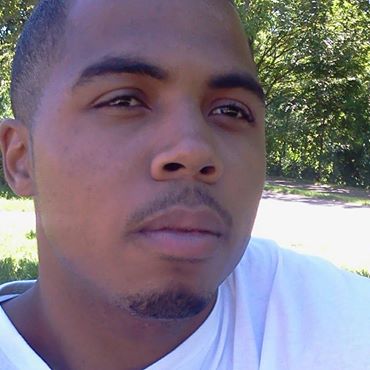
There is nothing legally holding back the mayor or the police chief from releasing the videos according to a Minnesota statute:
“Any law enforcement agency may make any data classified as confidential or protected nonpublic […] or as private or nonpublic […] accessible to any person, agency, or the public if the agency determines that the access will aid the law enforcement process, promote public safety, or dispel widespread rumor or unrest.” – Minnesota Statute Section 13.82, Subdivision 15
Deputy Chief Art Knight said on the night of the killing that he wishes Minneapolis “did like other cities” and released the footage to the public right away. Chief Arradondo, meanwhile, has stated that he would let the BCA carry out the release when they are done with their full investigation.
Yet, a month after promising to release the videos, the mayor had to, once again, make a public statement they would release the videos. This time he put a date on it: the end of July.
CALLS FOR CITY COUNCIL CONTROL OVER THE MPD
In the days following Blevins’ death, the Minneapolis City Council had also released a joint statement calling for the videos to be released as soon as possible, but since the shooting, members of the overwhelmingly “progressive” city council have become ensnared in a tense debate over a Police Department charter amendment.
Twelve members of the DFL and one Green Party member make up the thirteen member city council. Incumbents elected since 2014 include: Jeremiah Ellison, an organizer and longtime Minnesota politician’s son; Abdi Warsame, the first Somali to become a council member; Phillipe Cunningham, one of the first openly transgender men; and Andrea Jenkins, the first openly transgender woman ever elected to public office in the US.
On July 20, Green Party member Cam Gordon’s city charter amendment was approved for further discussion. It would allow the Mayor and City Council to exercise joint responsibility for the policy decisions around the Police Department. Cunningham said he supported the amendment, and supports
“…the city council having legislative authority over the police department – legislative not executive. We are not talking about 14 people with executive authority over the police department. We are talking about what many other cities including Seattle and New York… have, which is a more transparent legislative process for making policy changes in how their police department operates.” – Council Member Phillippe Cunningham, Ward 4 (Video @ 52min)
The proposed charter amendment is now headed to the Intergovernmental Relations Committee meeting, where public comments from the community will be heard. The meeting is scheduled for August 1, 2018 at 2:30 pm in the Minneapolis City Council chambers. If passed, the charter amendment will be on the November 6, 2018 general election ballot.
NEW MPD DATA SHOWS RACIST POLICING CONTINUES CONSISTENTLY
In a new transparency project, the Minneapolis Police have recently released large sets of very detailed data showing police stop information, crime data, arrest data, and use of force incidents. The MPD claims the data shows some positive results and that their use of force incidents level is the lowest since they started recording the data in 2008.
Yet, also embedded in the data is statistical proof that racist policing is a constant in Minneapolis, with 23% of the use of force incidents happening to white people (which in these cases of demographics, white includes people of Latino background) and an average of 62% of use of force incidents happening to African-Americans over the last five years. It was 61% in 2017.
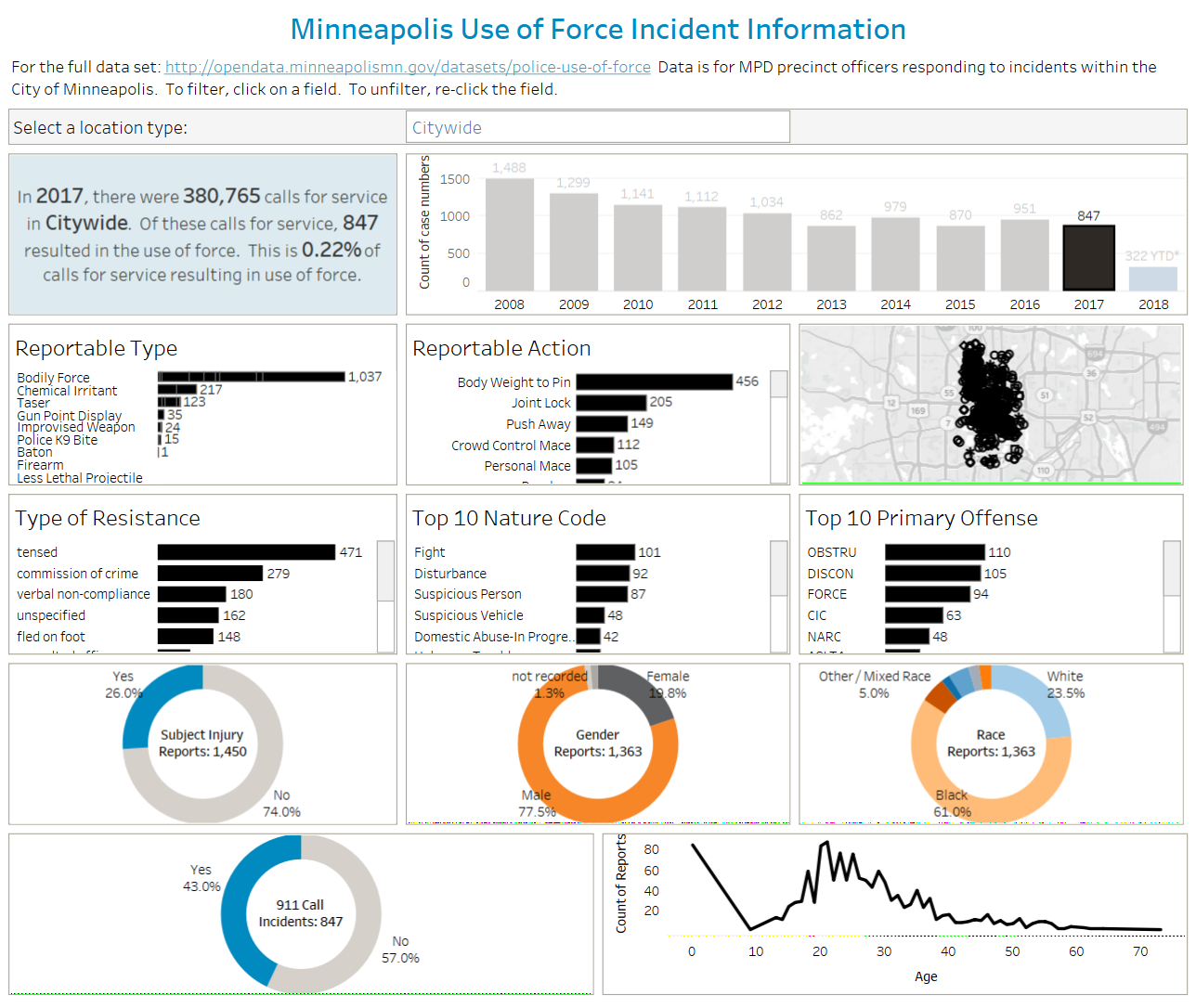
In early June, MPD came under fire for a string of sting operations in downtown Minneapolis targeting low-level marijuana sales. The Hennepin County Public Defenders Office made public the fact that 46 of the 47 people arrested for the small amounts of sales were Black, and that they were also being charged with felonies even though Minnesota laws state that under 42.5 grams of marijuana is a misdemeanor charge.
Police Chief Arradondo announced an end to sting operations targeting low-level marijuana sales shortly before the Hennepin County Attorney’s Office pushed to lower or divert the charges against the 47 wrapped up in the sting.
Many people see the attitude and culture set forth from the top-down by people like Bob Kroll, the President of the Police Federation and a known racist involved in the off-duty law enforcement motorcycle gang called City Heat, as part of the reason we see the continuation of everyday racist policing.
City Heat members have been documented wearing patches with white supremacist symbols such as swastikas and iron crosses and confederate flags, KKK symbols and more. Kroll has had multiple lawsuits filed against him for his vicious racially-motivated attacks while on duty for the Minneapolis Police Department, as well as at least 19 internal affairs complaints. Kroll denies that he is racist.
There has been a notable continuing power struggle within the MPD and top political ranks in Minneapolis. The previous police chief (Janeé Harteau) and mayor (Betsy Hodges) had many conflicts with the top brass from the police federation.
An example of this conflict was the #pointergate story in late 2014, when law enforcement officials gave KSTP a picture of then Mayor Betsy Hodges posing with a neighborhood political canvasser saying the mayor and the canvasser were both posing with gang signs. The root of the beef was the mayor making calls for independent investigations into police misconduct, which angered the police union.
This beef from the police union (federation) to the leadership to the politicians has seemingly continued. The sitting police chief is, as stated earlier, the victor against veteran mainstays in the MPD in a racial discrimination lawsuit, and certainly from the outside perspective has more support from the community and politicians than the head of the federation.
MPD URGED MEDICAL PROFESSIONALS TO INJECT DETAINED PEOPLE WITH KETAMINE
A scathing new report (PDF) released on July 26, 2018, details how Minneapolis Police officers urge ambulance staff and medical workers to inject detainees with the powerful and dangerous sedative, ketamine, before they’re hospitalized or even jailed. Numerous times, people injected with ketamine suffered heart and breathing failures, lost consciousness, and had to be resuscitated.
The problem became apparent during a 2017 audit on police body cameras, researchers took notice of police officers detaining people and then having emergency medical staff (EMS) inject them with ketamine.
Analyzing the police reports, OPCR found that the use of ketamine by police has dramatically increased in the last three years. In 2017, there were 62 instances of ketamine use in police reports but before 2015, there was only an average of 4 mentions of ketamine use on detainees in police reports per year.
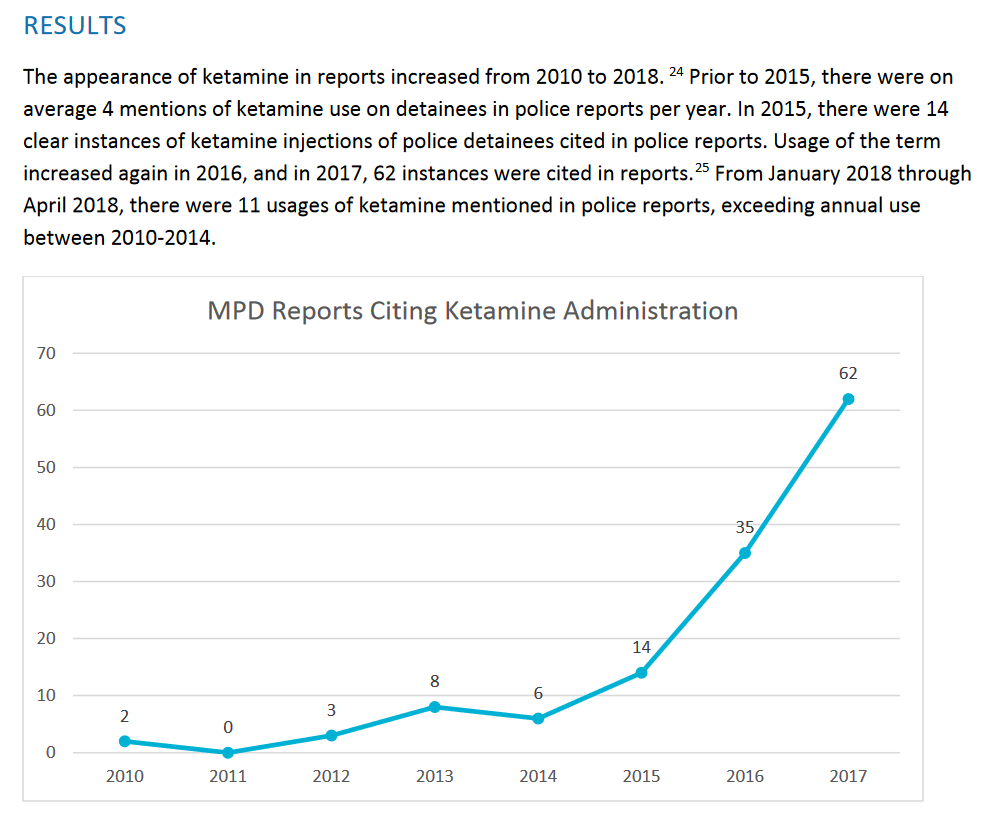
MINNEAPOLIS TRANSIT POLICE KNOCK OUT A YOUTH AT A BUS STOP AND PARK POLICE DETAIN 13 YEAR OLDS AFTER UNFOUNDED 911 CALL
It’s not just the Minneapolis Police tied up in high-profile incidents: the Metro Transit Police and Park Police have also been getting negative publicity by the actions taken by officers, which recently resulted in a knockout blow, and national news organizations covered the detainment of a group of youth after a 911 call in a park.
Three days after the killing of Thurman Blevins, a Metro Transit officer punched a youth, knocking him unconscious for several minutes. In a recorded video you can see a crowd reacting angrily after the officer knocked out the youth, asking why the officer would just punch him like that.
The victim, handcuffed the whole time during the four minute video, seemed to experience a seizure and vomited white liquid while the arresting officer, the one that hit him, held his head up at a downtown transit stop.
In July, the Minneapolis Park Police willingly participated in another phenomenon sweeping America, detaining people of color after unfounded 911 calls from caucasian callers.
Video taken on July 10, showed Park Police improperly detaining a group of young Somali teenagers at Minnehaha Park. The four youth, ages 13 and 14, had the police called on them by a white couple who were calling the teenagers racist names and threatening the teens.
The teens said that they thought the police were gonna kill them. That they felt that was the last day on earth. That fear of death by the police is a reality that many live with.
In June 2018, a video showed MPD officers drawing their guns on unarmed Somali youth while responding to a midday 911 call from the owner of the Nomad Pub, a local bar in the West Bank neighborhood of Minneapolis. The youth had guns pointed at their heads and were handcuffed. They were detained for a short while before being released with no charges after having their pictures taken by MPD.
https://twitter.com/WEST_BankRR6/status/1003879367724892161
Many artists in the Twin Cities scene have since proclaimed their boycott of the Nomad, stating the owners actions in “racial profiling” and calling 911 have led to a major backlash from their supporters.
According to data collected by the Star Tribune, police officers have killed 168 people since 2000 in the state of Minnesota. The Minneapolis Police Department have killed 30 people in the last 18 years. In Minneapolis, 20 people were killed by police in the first seven years of the 2000s and 10 people have been killed since 2008. The last four killings in Minneapolis were Thurman Blevins (2018), Justine Damond (2017), Raul Marquez-Heraldes (2016), and Jamar Clark (2015).
POLICE TRAINING AN ISSUE
Unicorn Riot reported in May, amidst contention, Chief Arradondo took his employees out of a fear-based training called Bulletproof (in which Jeronimo Yanez attended two years before killing Philando Castile) along with a few other departments. Fear-based training has become a hot topic in Minnesota and across the nation.
Police need licenses and training to become and remain a police officer. In Minnesota, they are required to complete 48 hours of continuing education credits, managed by the Board of Peace Officers Standards and Training (known as the “POST Board”).
Ex-cop and now ethical police trainer, Mike Quinn said at a recent public forum on police education, covered by Unicorn Riot, that by training focused on good behavior, the police interact with the community in a much more positive way. Quinn has worked for a few years on a pilot training program called EPIC that has helped stop excessive force incidents in the New Orleans police department.
Quinn spoke against Kroll, calling him “one of the biggest bullies on the whole police department” and said the culture within the Minneapolis Police Department, derived from leaders like Kroll, pushes back on officers who “step outside the lines” of silence by doing such things as not showing up during a back-up call or not showing up to give statements.
Despite a new police chief and mayor, a “progressive” city council, and an involved community, and despite use of force incidents being down, negativity continues to shine brightly on the MPD, as clear cases of racist policing are commonplace and complaints are peaking.
Stay tuned with Unicorn Riot for more reports in the future.
UPDATE – July 31, 2018 2:30 pm Central: Body camera footage was released Sunday, July 29, showing Blevins had a gun. The next day, Hennepin County Attorney Mike Freeman announced that no charges would be filed against MPD officers Justin Schmidt and Ryan Kelly.
No Charges Filed in Blevins’ Killing as Body Camera Footage is Released
To help us continue our work and fund our volunteer operated, horizontally organized, non-profit media organization, please consider becoming a monthly sustainer with tax-deductible micro-donations:
